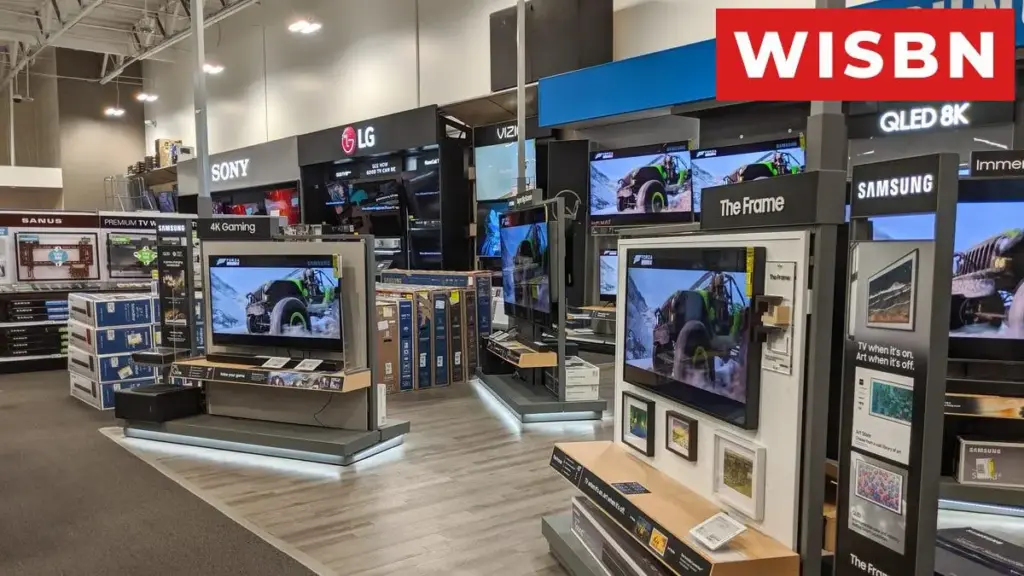While there are a ton of marketing buzzwords, almost every TV you’ll find today is either LCD or OLED. LCD sets are often marketed as LEDs, QLED TVs or even mini-LED, but the underlying technology is LCD — short for Liquid Crystal Display. Behind that LCD layer sit LEDs; the quantity and layout of those LEDs are the primary distinctions. The top models use quantum dots and local dimming to produce a vivid, 4K HDR picture. OLED, or organic light-emitting diode, is newer to mainstream consumers, though it’s been available for over a decade. OLED panels are manufactured by LG and Samsung and are also labeled QD-OLED or WOLED, depending on the particular implementation.
How they operate (the oversimplified version)
The largest difference between the two technologies is how they generate light. Every TV image is made up of millions of tiny “pixels,” or picture elements, that combine to form the image. With OLED, each pixel emits its own light, so there’s no separate backlight. With an LCD TV, all pixels are lit by an independent LED backlight. That backlight might have just a few LEDs in smaller, budget sets, or hundreds to thousands of LEDs in larger, pricier models.
This distinction in how they produce light directly affects overall picture quality, some aspects favoring LCD, but most favoring OLED.
LCD panels are produced by several manufacturers across Asia. All current OLED panels are made by either LG Display or Samsung Display, the panel-making arms of those corporations. Other brands will purchase panels from those suppliers, sometimes even trading among themselves, but if you’re buying an OLED TV the actual image panel was made by one of those two companies.
OLED is consistently, year after year and in test after test, the picture-quality champion, but LCDs usually cost less and can still deliver excellent image quality. A range of newer technologies, which we’ll cover, help keep LCD competitive with its newer rival.
So which is superior? Read on for their pros and cons. In general, we’ll compare OLED to the best (read: priciest) LCDs have to offer, mainly because cheap OLED TVs don’t really exist (yet).
Light output (brightness)
Winner: LCD
Loser: OLED
Take this category with a caveat. Both TV types can get very bright and can look good in a sunny room, as well as in more typical indoor lighting or the dark rooms that make images pop. At the end of the day, no modern TV is what you’d call “dim.” LCD earns the edge here specifically because the entire screen can reach higher brightness, which is a function of its backlight. Generally, mini-LED offers the peak brightness. Both QD-OLED and LG’s new 4-stack OLED still provide impressive luminance, so the gap isn’t as wide as it once was.
Black level
Winner: OLED
Loser: LCD
On the opposite end of brightness is black level, or how deep the TV can render darkness. OLED wins this because it can switch off individual pixels entirely, producing genuine perfect black. The better LCDs have local dimming, letting regions of the screen dim independently. That isn’t as precise as per-pixel control since dark areas aren’t absolutely black, but it’s better than nothing. The top LCDs use full-array local dimming, which gives much finer contrast control — yet even they can experience “blooming,” where a bright region washes out an adjacent dark area. Notably, mini-LED has far more LEDs than traditional LED LCDs, so in some scenes it can approach OLED’s performance.
Contrast ratio
Winner: OLED
Loser: LCD
This is where it all comes together. Contrast ratio measures the gap between a display’s brightest and darkest output. OLED takes the crown because it can achieve very high brightness while also producing absolute black with no blooming. It delivers the best contrast ratio of any modern screen.
Contrast ratio is the most critical part of picture quality. A display with a high contrast ratio will look more lifelike than one with a lower ratio. There’s a much bigger spread between the best LCDs and the worst, with mini-LED once again offering the top performance among that group. Even the “worst” OLED will still outmatch almost all LCDs, however.
Resolution
Winner: Tie
This one’s straightforward. Both OLED and LCD are widely offered in UltraHD, aka 4K, and there are 8K variants of both if you have deep pockets. There are also small, cheap 1080p and even 720p LCDs. There are no 1080p or lower-resolution OLEDs currently available.
Refresh rate and motion blur
Winner: Tie
Refresh rate helps reduce motion blur, or the smearing of anything moving on screen (including the whole image when the camera pans). Unfortunately, today’s OLEDs still exhibit motion blur, just like LCDs. OLEDs and mid- to high-end LCDs often have a 120Hz refresh rate. Budget LCDs are typically 60Hz. Remember, many makers advertise numbers higher than the “true” refresh rate. OLEDs and many LCDs use black-frame insertion, a technique that improves motion clarity without causing the (usually disliked) Soap Opera Effect.
Viewing angle
Winner: OLED
Loser: LCD
One of LCD’s main drawbacks is that the image quality changes if you sit off-center. How much that matters depends on your seating layout — and how many people you want to please. A few LCDs use in-plane switching panels, which offer better off-axis performance than other LCDs but don’t look as good straight on (primarily due to a lower contrast ratio). OLED doesn’t suffer the off-axis problem; its picture appears essentially the same even from extreme angles. So if you need a wide viewing area, OLED is the superior pick.
High Dynamic Range (HDR)
Winner: OLED (with caveats)
Viewing High Dynamic Range content lets your TV stretch its capabilities — like driving on the highway instead of a two-lane dirt road. It allows the TV to render brighter highlights and usually a broader color gamut. Nearly all current TVs support HDR, but that’s not the whole story. A TV claiming HDR support doesn’t guarantee it can accurately show HDR material. All OLED TVs have the dynamic range needed to take advantage of HDR, but lower-cost LCDs, especially those lacking local-dimming backlights, do not. So to see HDR content in its full, vibrant glory, choose OLED or an LCD with local dimming, such as mini-LED.
In our comparisons of the best new OLED and LCD TVs with HDR games and films, OLED typically looks better. Its superior contrast and absence of blooming prevail even though LCDs can get brighter. In short, LCDs can reach higher luminance, particularly in full-screen bright scenes and HDR highlights, but none can control that light as precisely as OLED.
Expanded Color Gamut
Winner: Tie
Wide Color Gamut, or WCG, relates to HDR, though you can technically have one without the other. It expands the range of colors a “standard” TV can display. Think richer, deeper, more saturated hues. Most mid- and high-end LCDs and all new OLED models support WCG. In several models of both, this capability comes from using quantum dots.
Uniformity
Winner: OLED
Loser: LCD
Uniformity means evenness of brightness across the screen. Many budget LCDs are poor here, “leaking” light from the edges, which can be distracting during darker films. On mid- and higher-end models this tends to be less problematic.
Energy consumption
Winner: Basically a tie
OLED’s power draw is tied to screen brightness. The brighter the image, the more power it consumes. It even varies by content: a dark movie uses less energy than a hockey game or a ski race. LCD energy use depends on the backlight setting. Lower backlight levels mean lower power usage. A simple LED LCD with a low backlight will use less power than an OLED. Overall, though, modern TVs are fairly energy efficient, and even the least efficient current set would only add a few dollars to your annual electricity bill. That said, larger, brighter TVs consume substantially more energy than smaller, dimmer ones.
Lifespan
Winner: Tie (sort of)
LG has stated their OLED TVs will take about 100,000 hours to reach half brightness, a number similar to LED LCDs. Broadly speaking, modern TVs are reliable and should last many years. Does that mean your new LCD or OLED will endure for decades like your parents’ old CRT (pictured)? Probably not — and besides, why would you want that? A 42-inch flat panel cost $14,000 in the late ’90s, and now a 55-inch TV with more than 16x the resolution and vastly better contrast sells for $250. In other words, by the time you’ll want to replace it, there will be something even better and cheaper. Because they are generally dependable, you likely won’t need to replace them anytime soon.
Burn-in
Winner: LCD
Loser: OLED
Both TV types can experience “burn in” or image persistence, where a faint ghost of an image remains on screen. It’s very hard to induce this on most LCDs. It’s easier with OLED, so LCD wins this round. Even so, most OLED owners won’t encounter burn-in. Some edge-lit LED LCDs, typically cheaper models, can experience a similar issue where aging LEDs and warped or discolored plastic layers degrade the image. So both technologies have their quirks, but they manifest differently.
Screen size
Winner: LCD
Loser: OLED
OLEDs are offered in sizes from 48 to 97 inches, but LCDs are available in smaller and much larger sizes — with many more size choices in between — so LCD takes this category. At the extreme high end, however, the largest “TVs” don’t use either of these technologies. The simplest and most affordable way to get a truly huge image at home is a projector. For about $1,000 you can get an excellent 100-inch-plus picture. If you want something even brighter and don’t mind spending a fortune, Samsung, Sony, LG and others sell direct-view LED displays, typically microLED in many cases.
Price
Winner: LCD
Loser: OLED
You can find 4K, 50-inch LCDs for under $200. It will be a long while before OLEDs reach that price point, though they’ve become significantly cheaper. If your aim is the least expensive TV possible, that’s LCD. If you want great picture quality, prices are fairly comparable. The priciest OLEDs cost more than top-tier similarly sized LCDs, but that gap narrows each year.
And the picture-quality winner is … OLED
OLED dominates the subjective picture-quality rankings because it’s cheap to manufacture LCDs and they deliver adequate picture quality for most people. But according to reviews at CNET and elsewhere, OLED takes the crown for overall image quality, largely because of its incredible contrast ratio. The price gap isn’t as large as it used to be, and in the mid- to high-end market there are many choices. LCDs keep improving, and many models deliver excellent image quality for much less money than OLED, especially in larger sizes. Which is to say, there are lots of great TVs out there.
Modern display technology continues to evolve rapidly. For example, Understanding RTX on Nvidia Graphics Cards shows how similar advancements are happening in other visual tech sectors.


